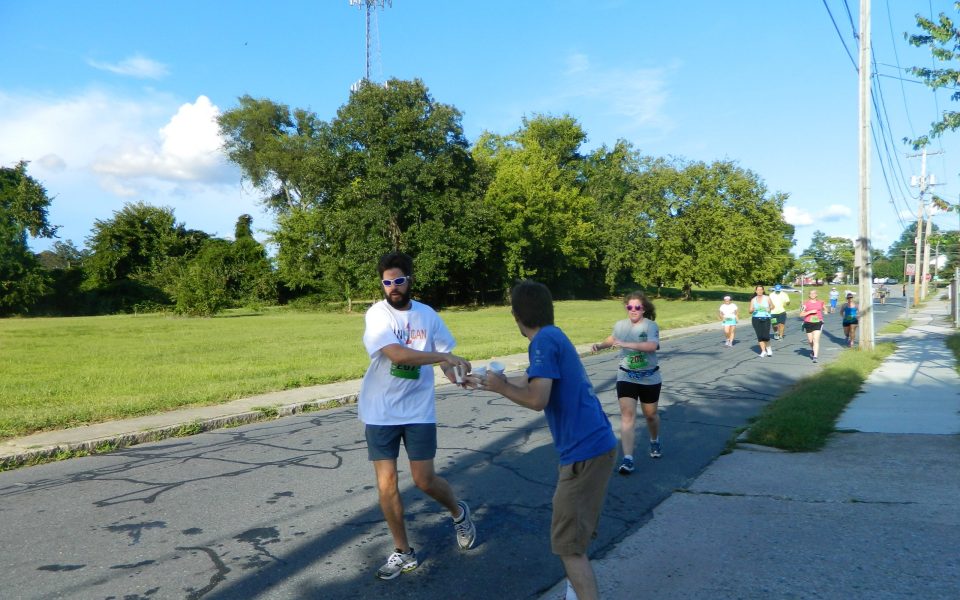by Jordan Green
Davis is the first volunteer to report to the water station.
When my wife and I slow to a stop on Bragg Street near the cab company, he was filling Styrofoam cups with water.
It’s his idea, after Cheryl and I showed up to join him with our 13-month-old baby in tow, to move the water station out of the sun and onto a sidewalk across the street.
After a fourth volunteer shows up, we stood around making small talk — about our families, babies growing up, college and running, along with our respective histories with Greensboro, volunteering and the Downtown Greenway.
Nothing binds me to Greensboro quite like the Downtown Greenway, with the possible exception of the truth and reconciliation process. That’s a story for another day, but suffice it to say that I formed some crucial relationships and developed formative impressions of the dynamics of how power and privilege are maintained in this community through the various ways we have dealt with the reverberating pain of an incident in which Klansmen and Nazis opened fire in a black housing project as police stood aside. For me, it pulled back the curtain on Greensboro.
In an odd way, the construction of the greenway operates as a positive inverse to the unresolved tragedy of the 1979 Klan-Nazi massacre. In a city that is significantly divided by race and class — in ways that are more typical than unique — the greenway holds the promise of creating common ground and a new story that every Greensboro resident can claim.
I’ve walked the Chandler Concrete railroad spur near my apartment in Westerwood — the future western leg of the greenway. I’ve run the proximate five-mile course of the greenway a number of times. My wife and I pulled trash out of the woods to prepare the way for the leg between Spring Garden and Lee streets. I watched a young artist from Miami and his crew maneuver a telescopic boom onto the railroad tracks to paint a mural on the massive concrete columns supporting the Freeman Mill Road overpass. I’ve partied with city council candidates during a voter engagement event at the same spot.
I witnessed the controversy that accompanied the opening of the first leg of the greenway, running a meandering course behind the commercial lots along Lee Street and adjacent to the modest ranch houses of the Warnersville neighborhood. I remember the complaints received by city council members from residents of the historic African-American neighborhood that a set of art benches would attract prostitutes and drug addicts whose doings would be in full view of the neighborhood. I remember that former Councilwoman Dianne Bellamy-Small conducted some personal research by taking up a station on the greenway to verify that no derelict behavior was occurring. The unspoken subtext behind the paranoia about public safety and propriety was that Urban Ministry’s location at the corner of Lee and Eugene streets ensured that homeless people who use walking and biking as primary modes of transportation would be major users of the greenway.
In the years since I’ve run and walked numerous times on that stretch of the greenway without any kind of negative encounters.
Division is often more comfortable than coming together because it’s what we’ve grown used to. Homeless people and addicts over here. Lower-middle class African-American homeowners over here. College students over here. Young professionals over here. It provides a false sense of safety, but it feels sterile and lifeless. It wears thin when you start to consider that individuals from all the supposed categories are your friends and family.
No numbers or statistics should be required to convince you that greenways encourage community and promote health. And at this point, no one should doubt that the Downtown Greenway is driving economic development. The Greenway at Fisher Park apartments, the new retail cluster anchored by Gaia Conceptions on Guilford Avenue, Deep Roots Market and the announced brewpub on North Eugene Street should dispel any doubts.
I think the greenway also changes the way we look at the neighborhoods in our city. As my wife and I parked our car in Ole Asheboro for our volunteer shift, we admired the sturdy bungalows and well-kept yards. No longer did it feel like a distressed, isolated and neglected neighborhood, but rather like an appealing community within walking distance of downtown.
Within six minutes of the starting gun, the first wave of runners flies past the water station, few of them stopping for relief. But most of the runners are in a pack further behind that stampeded past for about three minutes. The runners gratefully snatch cups from our hands, splashing water into their mouths and down the front of their shirts. Three of us grab as many cups as we could and raced out onto the sidelines to hand them off while a fourth person continually filled new cups.
Most of us had been strangers up until about an hour earlier, but for that brief time we are united in a shared mission.
Join the First Amendment Society, a membership that goes directly to funding TCB‘s newsroom.
We believe that reporting can save the world.
The TCB First Amendment Society recognizes the vital role of a free, unfettered press with a bundling of local experiences designed to build community, and unique engagements with our newsroom that will help you understand, and shape, local journalism’s critical role in uplifting the people in our cities.
All revenue goes directly into the newsroom as reporters’ salaries and freelance commissions.


Leave a Reply